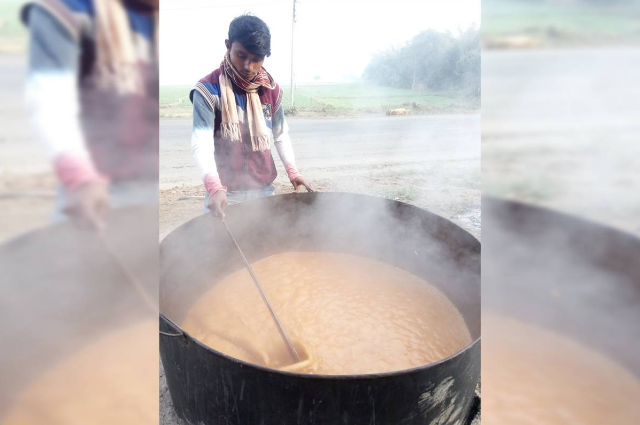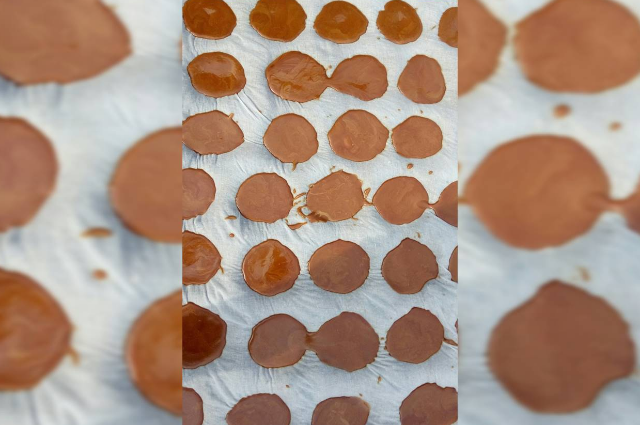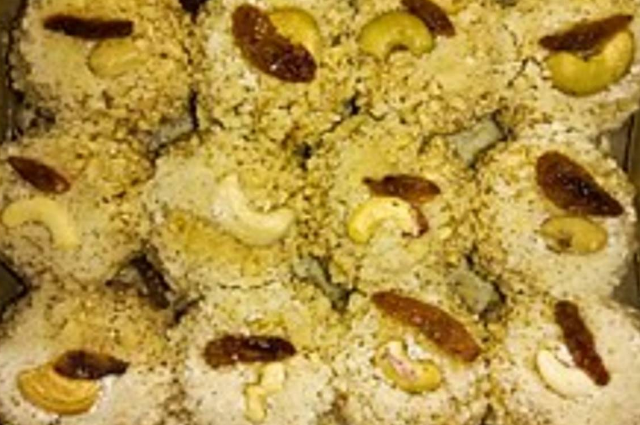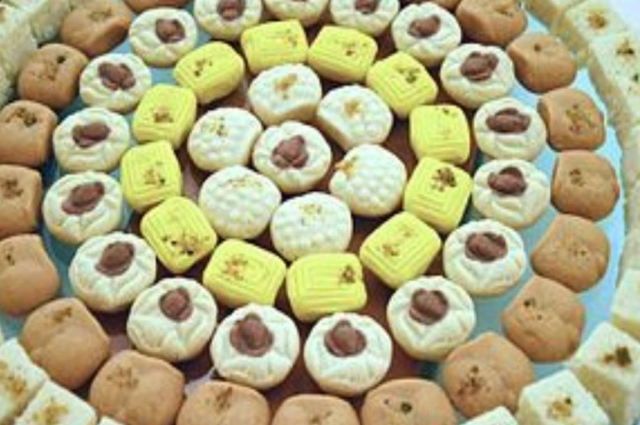
Picture by: Buddhadev Nandi
Introduction:
Moti’s infatuation with Phoolbanu could not be materialized because of his inability to meet Mehar (dowry) demanded by the latter’s father. Moti is a trader of jaggery made of khejur ros (date sap). His high-quality date jaggery prepared by Majubee, a widow, is a hot cake in the market. Moti hatched a plan with evil intentions. He married Majubee to put by money to pay Mehar to win Phoolbanu. He left Majubee and married Phoolbanu to be happy in his conjugal life.
But when winter set in, Moti was in deep water as the ‘nalen gur (date jaggery) prepared by Phoolbanu was not as sweet and delicious as his wife. At last, Moti surrendered to Majubee and the story ended with the emotional outburst of hugging both the ladies each other and shedding tears profusely. This is the plot of the film “Saudagar” based on the Bengali story ‘Ros’ written by Narendranath Mitra. The film starred by Amitabh Bachchan and Nutun Behl. The film still attracts cine lovers like that of Bengal’s nalen gur in winter.
Siulis of Bengal:
Though the date palm sap collectors and jaggery producers popularly called ‘siulis’ in Bankura district and surrounding areas predominantly belong to the poor male members of the Muslim society, the attraction of the people to nalen gur is still perfervid as Majubee’s infatuation to Moti. The date jaggery may be called one of the harbingers of winter in Bengal. If the olfactory tract of a grimmest jawed morning walker before sunrise is tantalized with the delicious fragrance carried by the north wind ranging from some distant field, he is certain that it is that of nalen gur bubbling in the flat tray on an oblong oven in some nearby mahal (a makeshift date palm jaggery manufacturing center surrounded by date trees).
Extraction of Date Sap:
Date sap popularly called khejur ros in Bengal is extracted from the date palm trees in winter. The reference to date palm tapping dates back to the pre-Christian era. Date palm sap like clean drinking water with high sucrose content collected from the vascular bundle of the trunks of date trees is a sweet and delicious drink. It is relished directly without any processing by people both in rural and urban folks. Besides, the date palm sap is allowed to ferment naturally and consumed as alcohol locally called khejur tardi, too. Palm tapping is strictly prohibited in many countries to prevent the potential danger of the abuse of fermented sap as alcohol for addiction.
The collection of date palm sap by tapping is a time-consuming and rigorous process. The mahal owners take the date palm trees on lease during the months of September and October to prepare the trees suitable for tapping. Palm trees of the age of five years or more having at least two feet of the woody stem are suitable for tapping. Pruning and trimming operations with dao (a sharp and slender incising instrument for pruning) and chisels begin from September up to the onset of winter. Pruning operation is done three to four times before tapping into the woody stem.
On the 7th day after the final pruning, a channel is incised one foot below the woody stem already prepared for tapping. A small pipe for the purpose of use as a sprout is fashioned from the bamboo stem. Then the sprout is inserted four to five inches into the woody stem. Pitchers made of clay nowadays plastic too is adjusted and tied with rope below the bamboo sprout to collect the sap. The pitchers are set in the evening for collecting the sap trickling down overnight. The jars filled with saps are climbed down at dawn before sunrise to avoid fermentation with the presence of sunlight.

Picture by: Buddhadev Nandi
Nolen Gur Producers:
Sabur Ali Bhangi, a sexagenarian, and his young son Sattar Bhangi run a mahal in an almost desolate village called Chandabera in the Bishnupur sub-division. They have nearly 250 date palm trees on lease surrounding their mahal. They do not trade date sap for drinking purposes. Their main product is date palm jaggery called nalen gur both in semi-liquid and block forms. Sattar said, “One guji (earthen container) date sap deposited per night from every tree is equal to five to six liters. However, the amount of sap mostly varies from the soil, the quality of trees, and the coldness of the weather. Besides, the male date palm trees produce more and sweeter sap than the female ones. The more the weather becomes cooler the more the sap is extracted from the trees.”
The extreme sweetness of the sap attracts bats and birds that are a carrier of the Nipah virus. Therefore, the containers are many times covered with nets to prevent the sipping of the sap by birds, bats, and pests. After collecting the sap, the tree is rested for three days to maintain the quality and quantity of sap and prevent premature death of the plant. Date palm sap is collected from one side of the tree in a season. Next season the pruning is done on the upper opposite side of the tree thus looking at zigzag cutting spots on the trunk of the date palm tree.
Sweet date palm molasses popularly called Nolen gur is eagerly awaited by food lovers to relish their tastes as well as the gachis (people engaged in the trade of date palm sap and jaggery) earn substantial amounts of profit. From pruning to preparing jiggery or nolen gur entails an arduous and long process. After extracting the sugary sap from the incision below the leaves of the plant, it is boiled in flat oblong trays made of tin on oblong ovens fuelled generally by dry leaves, pruned branches, and thin woods of scrubs. The sap is allowed to boil until it turns into thick jaggery called nolen gur.
How to Produce:
One guji containing about five to six liters of sap produces about a kilo of jaggery. However, one of the preconditions of preparing pure Nolen gur is that it should be made before sunrise to maintain its flavor and savour. Besides, the oven should not be ignited with high flame. A date palm tree per season yields about 40 kg of jaggery on average. Besides liquid treacle, khejur gur patali (jaggery slab and block) condensed in different shapes and sizes are hot cakes in the market during winter. Porridge and different types of sweetmeats including Sandesh, Rosogolla, Moa, etc are prepared with nolen gur patali (in block form).

Picture by: Buddhadev Nandi
Desserts Made of Nolen Gur:
Nolen gur is popularly used as an agent for enhancing the taste, flavour, and colour of desserts including moa, Sandesh, laddu, porridge, and pancakes made of rice flour. Joynagarer Moya named after the village Joynagar Mozilpur in the district of South 24 Parganas, the most coveted winter dessert, is prepared with date palm jaggery, khir (thickened milk), and khoi (a kind of soft puffed rice) of kanakchura dhaan (paddy). Nolen gur rosogolla is a mouth-watering dessert for which the people of Bengal eagerly wait. Soft balls of cottage cheese are dipped in the light brown syrup of nolen gur. Payes (porridge) is another sweet dish prepared with rice, milk, and spices perfectly charged with nolen gur to give it a peerless savour. Nolen gurer doi (curd) is sweetened with this special jiggery. Variety of sandesh, barfi, monda and even confectionary and ice cream are prepared with the ingredient of nolen gur. The festival of Makar Sankranti celebrated on the last of Bengali month Poush has deep connection with nolen gur. Woman folks prepare variety of pithas (pancakes made of rice flour) including dhdhpuli, patishapta, pulipitha etc with nolen gur and other ingredients. Besides, during marriage ceremony, New Year’s celebrations and other occasions desserts made of nolen gur are in great demand.
Panacean Properties:
Nolen gur, a winter staple in almost all the households in Bengal, is not only tasty but also is a storehouse of nutrients. It helps in promoting digestive system. It is rich in vitamins and minerals. Taking nolen gur during winter keeps the body warm and boosts up immunity power to prevent cold and cough. As a natural sweetener nolen gur, an amorphous form of unrefined and non-distilled sugar, can be used as a hygienic alternative to refined sugar aka ‘white poison’. It being rich in iron and potassium, helps to control our haemoglobin level. It also regulates our body’s electrolyte balance and lowers water retention for its potassium content. On the other hand, a good amount of magnesium content in nolen gur is helpful for our nervous system, muscles and bones. When menstrual cramps and PMS make few days of the moth unbearable, nolen gur can make one feels calm by releasing endorphins and easing pain. Besides, nolen gur that acts as natural pain killer, relieves migraine pain. Nolen gur is a good cure for soothing sore throat and gives relief from cold and cough. Seasonal consumption of the jaggery boosts up energy levels.

Nolen Gur Production at Stake:
There is much room for doubt whether the existing production of nolen gur if there is no probability of thriving, will sustain. Tradition workers called siulis who collect date palm sap and manufacture nolen gur are quite pessimistic. Filling of ponds and water bodies surrounded by date palm trees for unrestricted urbanization is one of the prime causes of the destruction of date palm trees in rural areas. The climatic situation unfavourable to date palm trees has intensified the situation. During super cyclones Aila, Amphan etc. a large number of date palm trees have been destroyed. Global warming or warming temperature is another major factor behind the reduction of the secretion of the sap. The favourable temperature for optimum quantity of sap to form is 14 degree Celsius. But the gradual increase in temperature has pushed this cottage industry into threat. As date palm sap is ultrasensitive, it begins to ferment with the rise of temperature. Besides, the secretion of date palm sap, according to many siulis, has mysteriously declined by 30% to 50%. However, some researchers have observed that the reduction of secretion in date palm trees is due to the decline of water bodies and the plummeting of water table.

conclusion:
However, a jiggery wholesaler admitted candidly, “Though nolen gur is hot cake in the market during mid winter, most of the customers cannot afford to buy it because of high price. Therefore, much of the date palm jiggery available in the market at the rate of Rs. 60 to Rs. 70 per kilo in the name of nolen gur is adulterated with refined white sugar and other type of cheap jiggery locally called veli gur. Pure nolen gur should be sold at the rate of Rs. 120 to Rs 150 per kilo.” His honest confession seems to remind one with the difference between the qualities of date palm patalis prepared by Majubee and Phoolbanu, the two wives of Moti. If Phoolbanu is the symbol of beauty that relishes the eyes, Majubee stands for quality that touches the heart. We the commoners are confused between these two.
